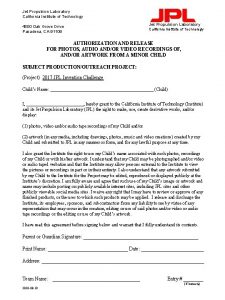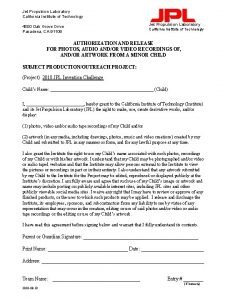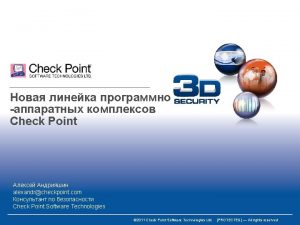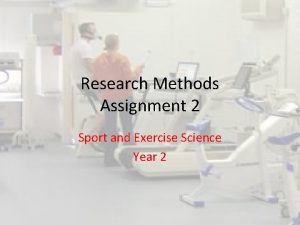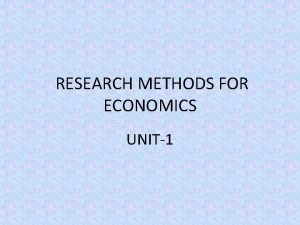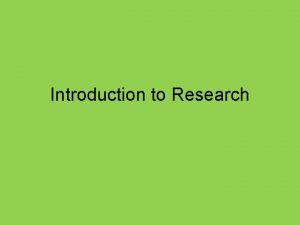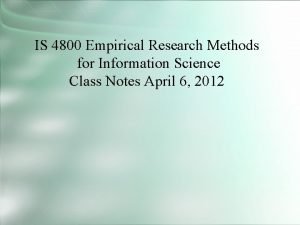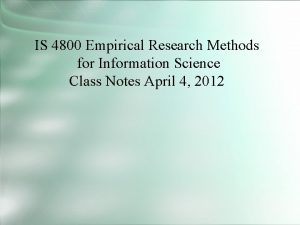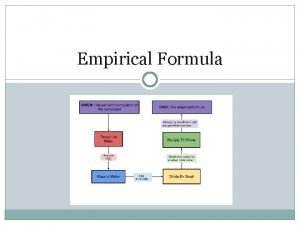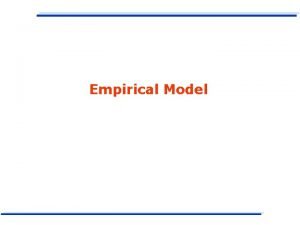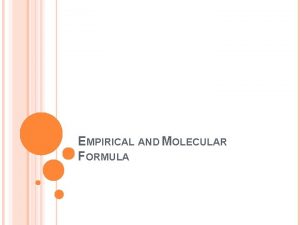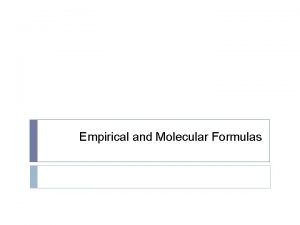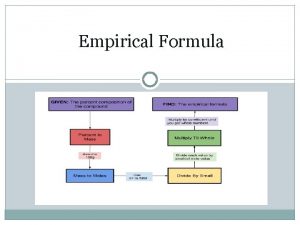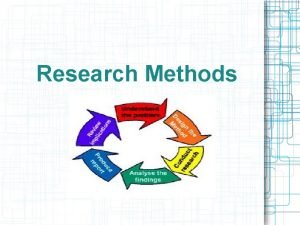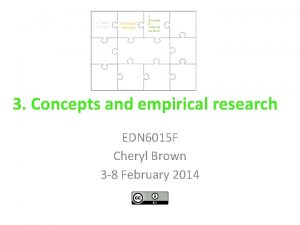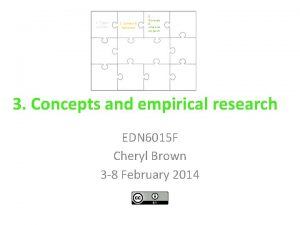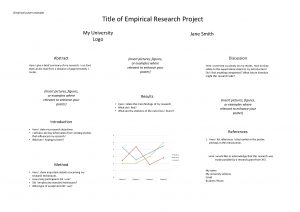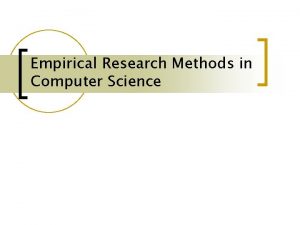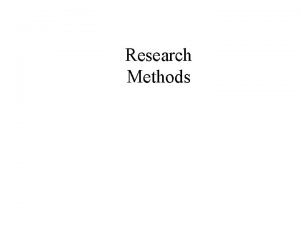IS 4800 Empirical Research Methods for Information Science

































































- Slides: 65

IS 4800 Empirical Research Methods for Information Science Class Notes Feb. 22, 2012 Instructor: Prof. Carole Hafner, 446 WVH hafner@ccs. neu. edu Tel: 617 -373 -5116 Course Web site: www. ccs. neu. edu/course/is 4800 sp 12/

Outline Review Hypothesis Testing Chi Square Test for Independence Correlation Writing Research Reports 2

Basic Process of Hypothesis Testing ■ H 1: Research Hypothesis: ■ There is a difference ■ H 0: Null Hypothesis: ■ No difference ■ The difference is “null” ■ Compute p(observed difference|H 0) ■ ‘p’ = probability observed random variation difference is due to ■ If p<threshold then reject H 0 => accept H 1 ■ p typically set to 0. 05 for most work ■ p is called the “level of significance” 3

Type of Errors in Hypothesis Testing “The Truth” H 0 True H 0 False Decide to Reject H 0 Type I Error Correct Decision Do not Reject H 0 Correct Decision Type II Error ‘p’ = p(? ) Probability of Type I Error 4

Procedure for Hypothesis Testing 1. Formulate your research (and null) hypothesis 2. Determine hypothesis test parameters – significance threshold 3. Collect your data 4. Compute a statistic 5. Compare the value to the criterion value for the statistic (using SPSS or a printed table) 6. If statistic value is greater, means p < threshold and you can reject null hypothesis 7. We say: this data supports the research hypothesis 5

Chi-Square Test for Independence ■ Are two variables related, or are they independent? ■ Assumptions ■ Both variables must be nominal (or treated as if) ■ Representative samples assumed ■ Normal distribution NOT assumed 6

Example ■ Morning & night people using different modes of transportation. ■ What kind of study is this? 7

Expected frequencies if variables are independent ■ E = (R x C)/N for each cell ■ R = row count ■ C = column count ■ N = total number in all cells 8

Expected frequencies if variables are independent ■ Step 1 – compute row & col totals 120 80 80 50 70 9

Expected frequencies if variables are independent ■ Step 1 – compute row & col totals ■ Step 2 – compute row % 120 80 80 50 70 10 60% 40%

Expected frequencies if variables are independent ■ Step 1 – compute row & col totals ■ Step 2 – compute row % ■ Step 3 – ea cell = (R x C)/N (48) (30) (20) (32) 80 (42) (28) 50 120 80 70 11

Formula ■ df = (Num. Rows-1)x(Num. Columns-1) 12

Using Chi-Square for Morning and Night Commuters

Computing Chi-square ■ SPSS: ■ run Non. Parametric/Chi. Square ■ See if significance<threshold • Yes => reject H 0 • No => inconclusive ■ Manually: ■ Determine df (= num categories – 1) ■ Compute Chi-square using formula ■ Lookup to see if statistic>table entry for thresholdsignificance, df • If yes => reject H 0 • If no => inconclusive 14

Correlation
















Written Study Reports ■ Objectives (also critiques) ■ Describe what your study is about ■ Motivate your study ■ Assure reader you have conducted a sound study • Research Methods – often presented in small font ■ Present results in an objective manner ■ Discuss implications ■ Discuss future work ■ Enable replication 31

Typical Study vs. IS/CS/HCI Paper Structure n n Astract Introduction n n n Method Results Discussion n n Motivation Related work Hypotheses Limitations Implications Future work References 32

Typical Study vs. IS/CS/HCI Paper Structure ■ Abstract ■ Introduction ■ Motivation ■ Related work ■ System design ■ Evaluation ■ ■ Hypotheses Method Results Discussion – summary, limitations ■ Conclusion ■ Implications ■ Future work ■ References 33

The Abstract ■ Concise summary ■ Abstract for an empirical study should include ■ Information on the problem under study ■ The nature of the subject sample ■ A description of methods, equipment, and procedures ■ A statement of the results ■ A statement of the conclusions drawn ■ Often the last thing you write 34

The Introduction ■ Part of paper giving justification for study ■ Usually has the following information ■ Introduction to the topic under study ■ Brief review of research and theory related to the topic ■ A statement of the problem to be addressed ■ A statement of the purpose of the research ■ A brief description of the research strategy ■ A description of predictions and hypotheses ■ CS/IS papers often put Related Work as a separate section after Introduction ■ For each, describe how your work is different 35

Organization of the Introduction: General to Specific 36

The Method Section ■ Includes information on exactly how a study was carried out ■ Subsections ■ Participants or subjects • Describe in detail the participant or subject sample • Human participants go in a Participants subsection, and animal subjects in a Subjects subsection ■ Apparatus or materials • Describe in detail any equipment or materials used • Equipment is usually described in an Apparatus subsection and written materials in a Materials subsection 37

The Method Section ■ Procedure ■ Describe • Exactly how the study was carried out • The conditions to which subjects were exposed or under which observed • The behaviors measured and how they were scored • When and where observations were made • Debriefing procedures ■ Enough detail should be included in all sections so that the study could be replicated 38

The Results Section ■ Objective, dry, boring – just the facts ■ All relevant data and analyses are reported in the results section ■ Do not present raw data ■ Data should be reported in summary form ■ Descriptive statistics ■ Inferential statistics ■ Results of descriptive and inferential statistics must be presented in narrative format ■ Describe the source of any unconventional statistical tests 39

Commonly Used Statistical Citations Statistical Test Format Analysis of variance F (1, 85) = 5. 96, p <. 01 Chi-square χ2(3) = 11. 34, p <. 01 t test t (56) = 4. 78, p <. 01 40

Abbreviations for Statistical Notation Abbreviation Meaning df Degrees of freedom F F ratio M Arithmetic average (mean) N Number of subjects in entire sample p p value SD Standard deviation t t statistic z Results from a z test or z score μ Population mean (mu) s Population stddev 41

The Discussion Section ■ This is where you can take some liberties with describing what the results mean ■ Results are interpreted, conclusions drawn, and findings are related to previous research ■ Section begins with a brief restatement of hypotheses ■ Next, indicate if hypotheses were confirmed ■ The rest of the section is dedicated to integrating findings with previous research ■ It is fine to speculate, but speculations should not stray far from the data 42

Organization of Discussion: Specific to General 43

Example 44

45

46

47

48

49

50

51

52

53

54

55

56

Citations ■ Liberally cite previous & related work. ■ If you copy passages you must cite and, depending on length, format to indicate it is copied. ■ Suggest using End. Note, Bib. Tex or similar. 57

Ethical Issues ■ Report all of your findings (not just the ones you like) ■ Adhere to your original plan ■ Report any deviations and why ■ Power analysis, statistics, measures ■ Do not drop subjects or data points without rigorous justification ■ If your hypothesis test was not significant you cannot say anything about difference in means (example). ■ If you did not do an experiment, attempting to control for extraneous variables, you cannot mention or imply causality. 58

Oral Presentation of Study Results 59

Oral Presentation ■ Main concepts and ideas ■ Do not go into great detail on experimental methods – just enough so people understand roughly what you did ■ Focus on motivation, results, implications ■ If listener wants details they can read the paper or ask questions 60

Oral Presentation Don’t do this… 61

Oral Presentation Do use as many figures as possible WEEK 4 CO M PO S BO ITE N TA D SK G CO O M AL PO SI BO TE N TA D S G K O A L WEEK 1 62

Oral Presentation Guide for Visuals ■ Visuals should be exhibits that you talk about ■ Do not put lots of text on charts ■ Do not read your charts for your presentation ■ Use interactivity, video, images to keep your audience awake 63

Common Questions ■ How did you evaluate that? ■ How did you measure that? ■ How did you control for extraneous variable X? ■ Why didn’t you use statistic Y? ■ Isn’t that a biased sample? ■ What was your control group? ■ How did you do study procedure Z? 64

Tips ■ Describe your sample ■ Minimal demographics – number of subjects, broken down by gender ■ Better: age, occupation, major, year ■ Minimize text on your charts ■ If you use a novel measure (e. g. , new survey) you must give details on the measure ■ Actual questions asked ■ Any reliability/validity/psychometrics done ■ If you do interviews, include actual quotes ■ Build from data to conclusions ■ Practice your timing/delivery with your project team 65
 4800 oak grove drive pasadena
4800 oak grove drive pasadena 4800 oak grove drive
4800 oak grove drive It was introduced by thomas cook in 1867
It was introduced by thomas cook in 1867 Sistema vds
Sistema vds Checkpoint 4800
Checkpoint 4800 Mazak fh4800
Mazak fh4800 Political science methodology
Political science methodology Research methods in exercise science
Research methods in exercise science My favourite subject is
My favourite subject is Wax pattern in dentistry
Wax pattern in dentistry Types of empirical research
Types of empirical research Applied vs fundamental research
Applied vs fundamental research Applied vs fundamental research
Applied vs fundamental research Kontinuitetshantering
Kontinuitetshantering Typiska drag för en novell
Typiska drag för en novell Tack för att ni lyssnade bild
Tack för att ni lyssnade bild Ekologiskt fotavtryck
Ekologiskt fotavtryck Shingelfrisyren
Shingelfrisyren En lathund för arbete med kontinuitetshantering
En lathund för arbete med kontinuitetshantering Kassaregister ideell förening
Kassaregister ideell förening Tidbok yrkesförare
Tidbok yrkesförare Sura för anatom
Sura för anatom Förklara densitet för barn
Förklara densitet för barn Datorkunskap för nybörjare
Datorkunskap för nybörjare Stig kerman
Stig kerman Att skriva en debattartikel
Att skriva en debattartikel Autokratiskt ledarskap
Autokratiskt ledarskap Nyckelkompetenser för livslångt lärande
Nyckelkompetenser för livslångt lärande Påbyggnader för flakfordon
Påbyggnader för flakfordon Lufttryck formel
Lufttryck formel Publik sektor
Publik sektor Bo bergman jag fryser om dina händer
Bo bergman jag fryser om dina händer Presentera för publik crossboss
Presentera för publik crossboss Jiddisch
Jiddisch Bat mitza
Bat mitza Klassificeringsstruktur för kommunala verksamheter
Klassificeringsstruktur för kommunala verksamheter Mjälthilus
Mjälthilus Claes martinsson
Claes martinsson Cks
Cks Verifikationsplan
Verifikationsplan Bra mat för unga idrottare
Bra mat för unga idrottare Verktyg för automatisering av utbetalningar
Verktyg för automatisering av utbetalningar Rutin för avvikelsehantering
Rutin för avvikelsehantering Smärtskolan kunskap för livet
Smärtskolan kunskap för livet Ministerstyre för och nackdelar
Ministerstyre för och nackdelar Tack för att ni har lyssnat
Tack för att ni har lyssnat Mall för referat
Mall för referat Redogör för vad psykologi är
Redogör för vad psykologi är Stål för stötfångarsystem
Stål för stötfångarsystem Atmosfr
Atmosfr Borra hål för knoppar
Borra hål för knoppar Orubbliga rättigheter
Orubbliga rättigheter Formel för standardavvikelse
Formel för standardavvikelse Tack för att ni har lyssnat
Tack för att ni har lyssnat Steg för steg rita
Steg för steg rita Verksamhetsanalys exempel
Verksamhetsanalys exempel Tobinskatten för och nackdelar
Tobinskatten för och nackdelar Blomman för dagen drog
Blomman för dagen drog Modell för handledningsprocess
Modell för handledningsprocess Egg för emanuel
Egg för emanuel Elektronik för barn
Elektronik för barn Plagg i gamla rom
Plagg i gamla rom Strategi för svensk viltförvaltning
Strategi för svensk viltförvaltning Var 1721 för stormaktssverige
Var 1721 för stormaktssverige Ellika andolf
Ellika andolf Romarriket tidslinje
Romarriket tidslinje
